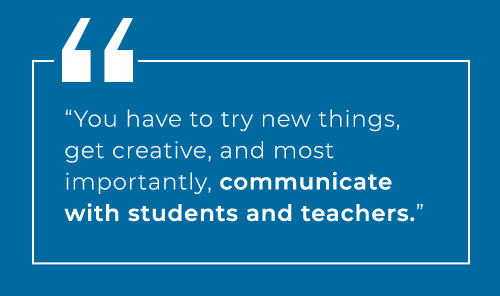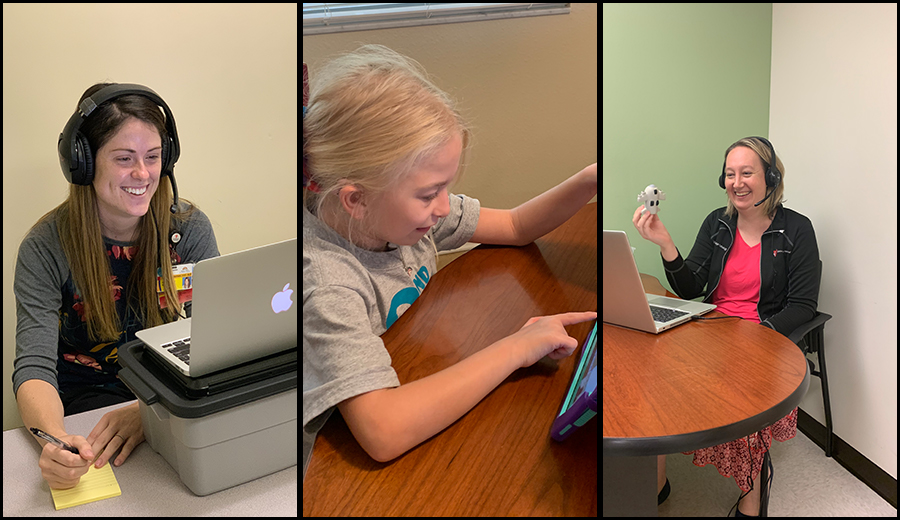Left to Right: Courtney Pakenham, Grace, Lindsay Zombek
Written By: Lisa A. Goldstein
At the end of March 2020, when much of the U.S. was under lockdown due to COVID-19, Lindsay Zombek’s department at University Hospitals Cleveland Medical Center started offering telehealth visits instead of in-person visits. Months later, the pandemic is still affecting us. What have practitioners like Zombek learned about having a successful telepractice, and how can families be prepared?
Learning Curve
Some practitioners like Zombek had to suddenly learn to operate remotely due to COVID. Others, like her colleague Courtney Pakenham, are fortunate to have prior experience with telepractice. In Pakenham’s case, when she was in graduate school, she saw several children virtually at the University of Akron. As a result, she had an idea of how teletherapy could work and who would be a good candidate.
Then there’s Alex Mestres, a specialist for those who are deaf and hard of hearing (TODHH) who provides support services through an itinerant model for charter schools throughout the state of Florida. Prior to COVID, she saw 11 students remotely across five different counties where there’s no TODHH available. Now between herself and her business partner, they see close to 50 students – all virtually.
When Mestres first started virtual education about 2 ½ years ago, the learning curve was steep. “Everything I learned was trial and error,” she says. “There was no one doing what I was doing that I knew of, so I was somewhat on my own in developing a format. Now there is so much more accessible support. With so many people doing virtual education, there are ideas out there specific to working with students [who are deaf and hard of hearing]. I am so impressed with how creative people are.”
Challenges
When Mestres first started telepractice, she says it was challenging, but in a good way. It really pushed her to re-think how she presents information. “The things you have been using when seeing students in person may not translate well to the virtual format,” she explains. “You have to try new things, get creative, and most importantly, communicate with students and teachers.” Her challenges varied depending on the school, student, or situation.
Of course, the first challenge is getting families on board. The majority of Zombek’s families were willing to try it out. Some of Pakenham’s parents and families were reluctant at first, but trusted her. Have patience; it’ll likely pay off.
“I truly believe just about any kid can be a good candidate for virtual therapy,” says Pakenham.
Zombek, who is team lead in Speech Language Pathology and president of the Ohio chapter of AG Bell, says that Auditory-Verbal (AV) therapy is excellent to use in a telehealth model, because many of AV’s primary principles involve coaching and guiding parents. As a result, many parents were familiar with carrying out activities with the child under the guidance of an AV practitioner.
Nonetheless, there have been many considerations to be learned along the way. One time, the tablet was direct streaming to the child’s cochlear implant, which disabled the tablet’s microphone. This meant Zombek and the parent couldn’t hear one another, yet the child heard everything.
Other challenges included finding activities that could be done together in a way that allowed Zombek to see what was happening. This involved some unique camera angles, device positioning, and creativity.
Closed schools and libraries meant that some families didn’t have access to printers, which prevented sharing some materials. Written educational materials and shared therapy materials had to be reimagined. Other families only had access to smart phones, which led to tiny screens and challenges seeing a shared screen.
Telepractice for Zombek and Pakenham’s department means using the platform Doxy.me, which the hospital felt had reasonable HIPAA compliance standards. Sometimes Pakenham uses Zoom. In the beginning, it was difficult for her to troubleshoot technical difficulties as a lot of strange things can happen with audio.
“I found that if a family was connecting with a phone, sometimes restarting the device helped to ensure audio connection,” says Pakenham. “On phones, other applications can take over the audio function. I wouldn’t say I’m particularly tech savvy, so having patience with the process was important. During the first few weeks, some sessions were seamless, and others I spent time on the phone with parents to help [them] get connected and work through audio issues.”
Benefits
When it comes to young children, goal-driven play-based therapy worked very well in telehealth, Zombek says. She could share real-time feedback with parents. “As a practitioner in a clinic setting, I loved getting to ‘be in the home’ and use the toys and materials the family has,” she adds. “I had to plan a little differently, but it really reinforced that if all parties involved know and understand the goal, then any material will work. It’s not the toy in therapy that helps the child develop language; it’s the work and input while using the toy that makes the difference.”
An unexpected perk to telepractice was that it forced Zombek to have conversations with parents about what they need now and what the challenges were with communication at home. Zombek typically has these conversations but so many new challenges emerged when people were at home all day, every day. “Many goals were changed to reflect immediate needs rather than just the ‘next step’ of a developmental model,” says Zombek. “I think this created better goals for some of the kids.”
Attendance was another benefit. Even if a family forgot, a friendly phone call reminder allowed most families to “jump on” immediately and still participate in the appointment.
Prior to COVID, successful telepractice for Mestres meant giving students access to a TODHH in areas where no provider was available. She has since had some unforeseen successes, like being able to co-teach with an intervention specialist, ESE teachers, and classroom teachers to show them how to best support the student. She has also been able to provide professional development virtually to help teachers understand what it means to have a student who is deaf or hard of hearing in their classes. She does emphasize that effectiveness must be evaluated for every student.

Practitioner Preparation
Mestres says a good understanding of platform capabilities is crucial. This also helps foster creativity. For example, Mestres has been able to integrate her Kindle app with Zoom to use books with students. Through Zoom, she can annotate and highlight these books for specific vocabulary or concepts. She can also drop PDFs into Zoom to work together with students on a lesson.
A headset is also a must. In the beginning, Pakenham just used her iPhone headset. It wasn’t the best, but it helped. Now she’s using a wired “gaming” headset with a noise cancelling microphone, which has helped immensely both with the projection of her voice and the ability for her patients to hear her. In addition, she always gets something to prop her computer up so it’s at eye level. She spent many weeks with a sore back before she made that adjustment. “Because I move locations during the week, I grab whatever is handy,” she says. “I’ve used books, step blocks, and Tupperware containers.”
A good suggestion from Pakenham is to send lesson plans and/or printouts for the family to have prepared. While this depends on the family, child, and goals, this helps the family know what to expect and allows materials to be handy. Having families send a toy inventory can be helpful too, she says.
Mestres suggests that TODHHs keep a record of what works and what doesn’t along with any challenges. “We need more research and to begin to establish best practices for virtual learning,” she says. “The only way that happens is with data.”
Client Perspective
Dina Curtis’ 7-year-old daughter who has a mild bilateral conductive hearing loss and wears hearing aids started telepractice in mid-March due to COVID. The Tampa resident does group speech therapy through school, private one-on-one speech therapy once a week for half an hour, and also meets with her TODHH weekly. She was already used to meeting with Mestres, her TODHH on Zoom, since Mestres is based in Miami. Speech therapy went well, although there were sometimes technical issues – but nothing major in Curtis’ opinion.
One challenge was making sure the speech therapist could see her child and her mouth. Hearing clearly can be an issue. But what Curtis likes about telepractice is the ability to hear what sounds her daughter is working on and the ability to reinforce those sounds at home.
While Curtis prefers in-person therapy, she’s appreciative of the technology to continue online. “As a parent, try to be as involved as you can,” she recommends. “Speech therapy works best when both the therapist and families work together.”
Indeed, telepractice can be successful. Zombek says the majority of children demonstrated continued progress toward goals once they switched to telepractice. And this might be the new normal, regardless of COVID. “When we opened our doors for in-person visits, families had their choice of in-person or continued telehealth,” Zombek says. “We maintained a large group of families that continued to feel that telehealth was working for their family and who wanted to continue.”
What should the practitioner have to prepare?
- Flexibility
- Open mind.
- Great headset with a microphone.
- Strong WiFi connection.
- Knowledge of the telehealth platform.
- Back-up activities, and then back-ups for back-up activities. If something goes wrong, you’re always prepared.
- Good communication with teachers and families.
What should the client do to prepare?
- To ensure a strong signal, make sure siblings have things to do that aren’t dependent on WiFi at the same time as the session.
- Come ready to work.
- Depending on the situation, you might need writing utensils, games, toys, little manipulatives, etc.
- Have the appropriate technology.
- Don’t let the child try to run the session.
- Limit distractions as much as possible.

